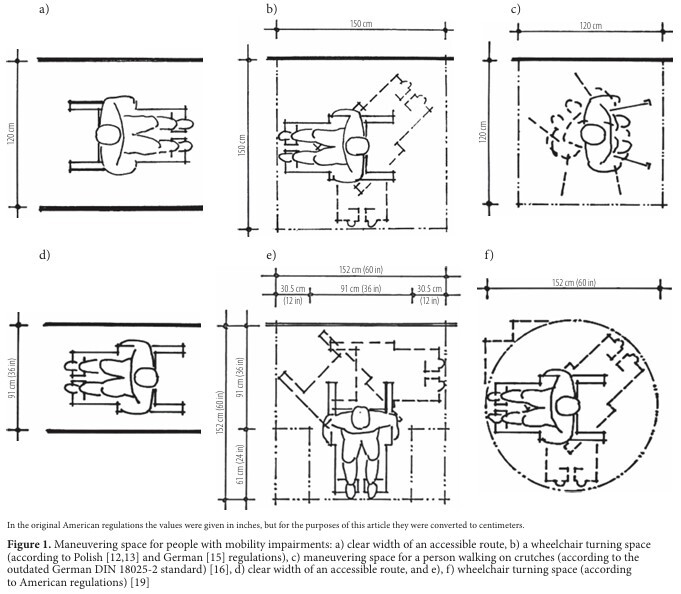Online first
Current issue
Archive
Most cited in 2024
About the Journal
Editorial Office
Editorial Board
Copyright and self-archiving policy
Information clause on the processing of personal data
Declaration of accessibility
Instructions for Authors
Instructions for Reviewers
Contact
Reviewers
2024
2023
2022
2020
2021
2019
2018
2017
2016
2015
2014
2013
Editing and translations
ORIGINAL PAPER
Designing movement space for elderly and disabled people in the construction law in selected countries
1
Wroclaw University of Science and Technology, Wrocław, Poland
(Faculty of Architecture)
These authors had equal contribution to this work
Online publication date: 2024-06-14
Corresponding author
Przemysław Nowakowski
Wroclaw University of Science and Technology, Faculty of Architecture, Prusa 53/55, 50-317 Wrocław
Wroclaw University of Science and Technology, Faculty of Architecture, Prusa 53/55, 50-317 Wrocław
Med Pr Work Health Saf. 2024;75(3):189-97
KEYWORDS
TOPICS
ABSTRACT
Background: Building law regulations determine designing the built environment recognising the needs of users of different ages and psychophysical abilities. Seniors and their spatial needs are covered there to a limited extent. The benchmark for design are wheelchair users. Their spatial requirements are greater in relation to independent walkers, including most older people. This makes it difficult to adapt the whole built environment to the needs of people with less mobility dysfunction. This can be considered in terms of spatial design and investment costs. Material and Methods: The paper analyses the building regulations of 3 countries in terms of legal conditions to shape the architectural movement space of older people and disabled people. Analytical and comparative methods are used. Such research is becoming relevant and necessary. The analyses are conducted in the context of ageing populations. They are justified by statistical data on the age groups of Polish society. This is followed by design analyses of the legal requirements in the wheelchair movement space and proposals for alternatives, e.g., people walking with canes (case study). Their aim is to indicate methods to limit excessive communication spaces in buildings while maintaining functional values for all users. Results: Research may show the possibility of greater diversification of regulations and alternatives to current laws. They are dedicated to participants in investment processes to shape accessible buildings. They can also be used in legislative work on amendments to the construction law. Conclusions: Changes in building regulations and a detailed approach to the mobility needs of older and disabled people (walking independently) are proposed. These decisions can provide benefits (spatial and economic savings). They fall into the “design for all” trend and sustainability of the built environment. These demands are based on no longer valid normative regulations. Med Pr Work Health Saf. 2024;75(3):189–197
We process personal data collected when visiting the website. The function of obtaining information about users and their behavior is carried out by voluntarily entered information in forms and saving cookies in end devices. Data, including cookies, are used to provide services, improve the user experience and to analyze the traffic in accordance with the Privacy policy. Data are also collected and processed by Google Analytics tool (more).
You can change cookies settings in your browser. Restricted use of cookies in the browser configuration may affect some functionalities of the website.
You can change cookies settings in your browser. Restricted use of cookies in the browser configuration may affect some functionalities of the website.






